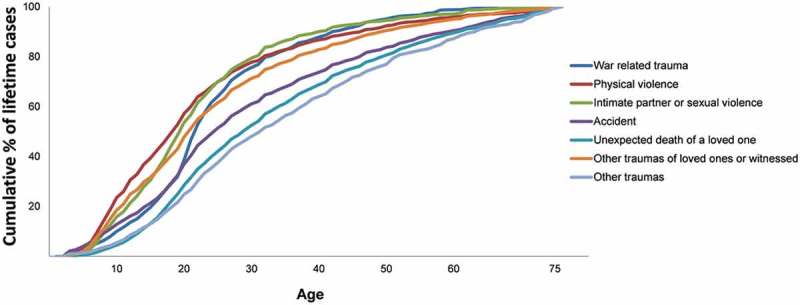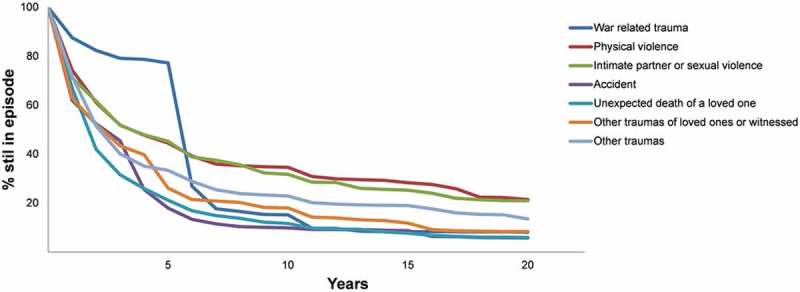Why Complex PTSD Should Be Included In The DSM

Studies have shown that “70% of people globally will experience a potentially traumatic event during their lifetime” (“Post-Traumatic Stress”). Of those, approximately 6% will develop Post-Traumatic Stress Disorder (PTSD). PTSD results from exposure to a traumatic event such as natural disasters, acts of violence, and prolonged exposure to abuse and neglect. The symptoms of PTSD typically entail re-experiencing the traumatic event through flashbacks, avoidance of related stimuli, hypervigilance, and negative thoughts or feelings about oneself or the world. However, the prevalence of PTSD increases in those who experience prolonged interpersonal trauma, or complex trauma. Exposure to complex trauma, especially in adolescence, disrupts the development of the individual and leads to an increase in post-traumatic stress. This disruption, however, cannot adequately be described by PTSD alone. Many clinicians, psychologists, and researchers recognize this as a distinct condition known as Complex Post-Traumatic Stress Disorder (CPTSD), Despite vast research and to the dismay of many clinicians, CPTSD has yet to be included in the Diagnostic and Statistical Manual of Mental Disorders (DSM). Due to the lack of inclusion in the DSM, research around CPTSD has been difficult, leading to a clinical misunderstanding of the complexities of different types of trauma, causing inadequate treatment outcomes as well as an over-pathologizing of symptoms that result from underlying trauma.


What Is The DSM?
The DSM, otherwise known as the Diagnostic and Statistical Manual of Mental Disorders, is a handbook used by mental health professionals to diagnose mental disorders and is published by the American Psychiatric Association (APA). The DSM evolved from systems of data collection and statistics by psychiatric hospitals and a United States Army manual as a way to create a distinct and coherent manual for mental health disorders using a common language and standard criteria (“Diagnostic and Statistical“). Today, the DSM is used by clinicians, researchers, drug regulation agencies, and insurance companies to diagnose and provide treatment. The importance of the DSM is apparent when providers “in the United States may require a DSM diagnosis for all patients with mental disorders in order to be approved for insurance and treatments” (“Diagnostic and Statistical“). Without an official DSM diagnosis, patients cannot be adequately treated, often leading to survivors of Complex trauma being diagnosed with other conditions that fit within the DSM framework, such as Borderline Personality Disorder (BPD).
Borderline Personality Disorder
Borderline Personality Disorder (BPD), as defined by the DSM, is a condition that leads to a pattern of instability in interpersonal relationships, self-image, and emotions, as well as problems with impulse control. To be diagnosed with BPD, one must present with five of these criteria:
Symptoms may include:
- Chronic feelings of emptiness
- Difficulties with emotional regulation
- Severe fear of abandonment that leads to frantic efforts to prevent perceived abandonment
- Unstable or negative sense of self
- Impulsive behavior that is self-destructive, such as binge eating or reckless driving
- Inappropriate or intense anger
- A pattern of unstable and intense relationships characterized by extremes of idealization or devaluation
- Suicidal threats or self-harming behaviors
- Periods of stress-induced paranoia or dissociation
Borderline Personality Disorder is a highly stigmatized disorder, often overly diagnosed in those assigned female at birth, with the trauma history of these patients often going unrecognized. Many providers do not want to work with these patients due to perceived treatment resistance and a high risk of suicidality and emotional volatility. (Choi-Khan and Gunderson). The stigmatization of BPD often leads to mistreatment and misunderstanding of the patient. It puts the blame on a patient’s personality rather than exposure to complex trauma. It has even been argued by some Clinicians such as Dr. Judith Herman that BPD may not be a personality disorder and rather a complex trauma disorder. However there is a significant debate on this
CPTSD’s Inclusion in the ICD-11
Similar to the DSM, the International Classification of Diseases (ICD) “is a global categorization system for physical and mental illnesses published by the World Health Organization (WHO)” (Cuncic). The ICD released its 11th edition (ICD-11) in 2018, and within this new iteration, they included the diagnosis of Complex PTSD, citing its distinction from PTSD as justification for its inclusion.
What is CPTSD?
Complex PTSD (CPTSD) is very similar to PTSD; however, it differs in that it results from prolonged exposure to trauma in an environment in which the sufferer has no escape, such as being in a concentration camp, prison, or subject to the whims of abusive parents (Herman). Like PTSD, sufferers of Complex PTSD also experience the core PTSD symptoms such as re-experiencing the traumatic event through flashbacks, avoidance of related stimuli, hypervigilance, and negative thoughts or feelings about oneself or the world. However, they also experience three distinct symptoms not currently recognized in PTSD.
As stated in The ICD-11:
Complex PTSD is characterized by severe and persistent problems in emotional regulation, negative sense of self, viewing oneself as diminished, defeated, or worthless accompanied by feelings of shame, guilt, or failure related to the traumatic event, and difficulties in sustaining relationships and in feeling close to others. These symptoms cause significant impairment in personal, family, social, educational, occupational, or other important areas of functioning. (World Health Organization 2018)
How BPD and CPTSD Get Confused
To the untrained eye, BPD And CPTSD can appear very similar as many of their symptoms overlap. Some similarities include difficulty with emotional regulation, unstable relationships, mood swings, fear of abandonment, and negative self-perception. However, these symptoms can present very differently in those with CPTSD. Those with BPD tend to have a severe fear of abandonment and can go to great lengths to avoid said abandonment and often swing between extremes of idealization and devaluation (American Psychiatric Association) While both have a negative self-concept, people with CPTSD have a more stable negative self-concept while BPD can shift rapidly between a highly positive and negative self-concept and those with borderline personality often change appearances and interests. Those with BPD are also more likely to engage in suicidal threats or self-harming behaviors (Psych2Go). CPTSD is directly a result of trauma and while BPD can also be triggered by trauma, it has a genetic component to it as well.
PTSD’s Inclusion in the DSM
PTSD has likely been with us since the beginning of trauma itself but was not formally recognized as a mental health condition until 1980, when it was included in the DSM-III. Before that, PTSD was labeled as “nostalgia,” “shell shock,” and “combat stress reaction. It took significant political activism and advocacy from trauma survivors to finally recognize PTSD as a legitimate diagnosis (Friedman). The DSM often has a rigid and conservative system of incorporating new diagnoses.
Similarly, CPTSD has been documented by several psychologists for decades. Dr. Judith Herman first introduced the concept of CPTSD in 1992 and attempted to get it included in the DSM as Disorders of Extreme Stress Not Otherwise Specified (DESNOS). However, CPTSD was not included, and instead, the PTSD diagnosis was changed to incorporate some of the complex trauma symptoms (Resick, Patricia A., et al). Now, 30 years later, CPTSD remains absent from the DSM, leading to misdiagnosis, inconsistent treatment approaches, and an over-pathologization of trauma symptoms (Miller John).
Argument Against CPTSD Being in the DSM
The historical arguments against CPTSD being included in the DSM is that there is not enough evidence to differentiate between other disorders such as PTSD, BPD. In addition, the differentiating symptoms of Complex PTSD are already covered by the criteria of BPD. Finally, there haven’t been enough studies done to prove effective treatment outcomes of complex PTSD compared to PTSD. Some argue Adding CPTSD to the DSM could further add confusion for diagnosis, as it overlaps so much with PTSD and BPD because “complex PTSD” is just the presentation of a combination of PTSD and BPD.
Conclusion
While CPTSD shares many overlapping symptoms with conditions such as PTSD and BPD, its root causes are different, as CPTSD results from complex trauma exposure rather than a singular traumatic event or a genetic predisposition such as BPD. A diagnosis of Borderline Personality Disorder may encompass similar symptoms but does not accurately describe a disorder caused by prolonged trauma exposure. Since its original conception by Judith Herman in 1992, more studies have been conducted to differentiate between PTSD and Complex PTSD, to the point where it has been included within the ICD-11. It is time that the DSM incorporates this diagnosis so that trauma survivors may be properly treated. Just like with PTSD, the inclusion of CPTSD in the DSM will likely require similar pressure from clinicians, researchers, and affected individuals, Complex PTSD is already a recognized diagnosis in many other countries, Failing to acknowledge CPTSD not only prolongs misunderstanding but also mirrors the very systemic neglect that led to the disorder’s development in the first place.
First Draft link https://thepsychdigest.com/my-drafts/